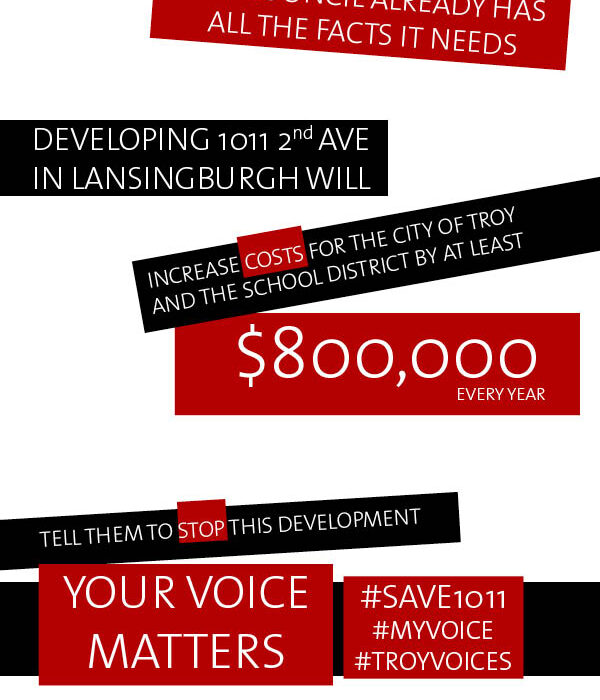- Development threatens last riverfront forest in Troy, NY, which is a critical historical-cultural site; would increase costs for city and school district for provision of essential services by an additional $500,000/year
- 500 people have signed petitions opposed to the rezoning
- A 30-page report, expert evidence submitted to city council planning committee for an August 27th Planning Committee meeting, detailed the development’s negative impacts and increased costs to the city
- City Council will vote on rezoning the parcel, a decision which would move the development ahead at a public hearing on September 10th.
- Opposition group “Friends of the Mahicantuck” mount public campaign, and offer a common-sense solution
TROY, NY: COMMUNITY VOICES STRONG OPPOSITION
TO PLANNED DEVELOPMENT; PROPOSE WIN-WIN SOLUTION
Troy, New York: Broad community opposition is pushing back against a proposed rezoning that is inconsistent with the city’s “Realize Troy” 2018 Comprehensive Plan. This rezoning would facilitate a planned development of 240 apartment units on the city’s last forest along the Hudson river, located in the Lansingburgh neighborhood.
The “Friends of the Mahicantuck” is a community organization that seeks an alternate vision for this site. The group argues that the development would destroy the city’s last waterfront forest and one of the region’s most significant archeological sites of indigenous history and culture. The group also calculated that the development will increase costs for the school district and the city by $500,000/year or more. “This number already includes anticipated revenues. It’s bankruptcy economics”, explains the group in a statement.
The group pushes the Troy City Council to save this ecologically, culturally and historically unique land (with artifacts dating back to 1500-3000 B.C.) and pushes for the creation of a historical and ecological preservation park that would better serve the community — and offers a common sense solution that should work for all involved parties.
Group Proposes Common Sense Solution To Preserve the Land and Create a Community Park
Support in the community is broad and growing: The “Friends of the Mahicantuck” have collected 500 signed petitions in one week, and the coalition now includes a broad cross-section of the city’s residents and electorate as well as local community organizations, and representatives of indigenous peoples with strong ties to this land.
The Friends group has the community’s backing in opposition to the development. But it also proposes an alternative plan. Jessica Bennett, a spokesperson for the group: “Let’s protect this land, create a historical and natural preserve with trails and community recreational opportunities and educational programs!” The group says it is ready to realize this vision, working with several regional and local organizations to secure funds and create capacities. “We are prepared to work with community organizations to create a protected space with public access, trails and educational opportunities at the land.”
The group doesn’t want the developer to lose out either. “Our goal is to protect this land”, Bennett explains, “but it is also to offer an alternative vision and a solution that can work for everyone.” There are several viable alternative sites that are already connected to city infrastructures, lie vacant and would not require the costly deforestation and leveling of this precious land. The recently closed Price Chopper just one block down the street comes to mind: Why not develop the Price Chopper property down the street?
Group Offers Viable Alternative to Developer, Pointing to Priorities Defined in City Policies
“The Price Chopper site is ideal” It is owned by the same people, there are currently no plans for it, and it would be cheaper and more efficient for the developer as well as the city to develop the same project there. Bennett concludes: “We absolutely would invite, welcome and support the developer in efforts to realize his vision in better ways by focusing on the many neglected and abandoned sites just around the corner.”
Bennett also points out that the site preparation cost at Price Chopper would pale in comparison to what is necessary to make the current proposal viable: “Even if they would have to raise the Price Chopper to better protect it from floods, that would be cheaper than what needs to happen to realize the current development plans at the forest site.” To allow for the development in its currently proposed form, the forest needs to be cut and the land’s rugged topography leveled. Further, significant flood risks are present there as well, “not to mention the protracted and lengthy process of getting approval for developing land, including involved studies and assessments.”
All of that is not a problem at the Price Chopper site, all of that has already been done, and it is identified in the Realize Troy Comprehensive Plan as a Major Reinvestment Area. The vacant Price Chopper site would also make sense, as the group points to statements by Troy’s Planning Commissioner Steven Strichman as well as City Council President Carmella Mantello. Mantello identified in a previous interview with the Times Union as “prime piece of waterfront property”, and Steven Strichman described it as an “unique opportunity” for a development project that can benefit both Lansingburgh and the city. The Comprehensive Plan also speaks clearly to the redevelopment of this site. “This does not only make this alternative site a good idea”, Bennett explains: “It is the stated policy of the city.”
The agreed upon vision of the administration, council and residents, adopted just two years ago is to develop the Price Chopper site and surrounding area. “I am sure a lot of time, effort, meetings, public input and analysis went into pages 69-72 of the Realize Troy plan.” At the same time, Bennett points out that developing the forest would only reduce economic demand for the Price Chopper site.
Bennett explains: “We welcome development, especially development consistent with Realize Troy, which prioritizes and focuses on the many vacant and abandoned buildings and properties across both the Lansingburgh neighborhood and the entire city. The abandonment and vacancy rate across the city is through the roof. Addressing that really helps the city and the local residents. So why go out of your way to destroy this beautiful land, when there are readily available opportunities to do good for the neighborhood right around the corner? I am sure the entire community would applaud him, would he choose to preserve this forest for the community and invest to revive the Price Chopper instead.”
With that, the Friends offer not only opposition, but a real opportunity to allow for all involved parties to get what they want: “Create a historical and nature preserve and park for the community, save the land, help the city to better utilize open spaces, and help the developer bring his project to the ideal site just around the corner in a way that is more cost effective for the city as well as the developer.”
Across the Lansingburgh area, this idea finds broad support that everyone could agree on: “It’s just common sense”, one resident explains. Bennett of the “Friends of the Mahicantuck” explains that everyone appears united in the fight against this development: “What is clear is that everyone agrees: this development location is just not a good idea, and it is not what the city’s policy is. Especially with such an easy solution at hand that just would work out better for everyone.”
Despite Broad Opposition, City Council Plans To Push Development Forward.
In the meantime, the city council appears for now to be determined to move forward with this development, despite mounting pressure from the public on both parties. The council will hold a public hearing on the rezoning for the planned 240-unit apartment complex development in Lansingburgh on September 10th.
“What the council will vote on is to ask the planning commission to weigh in and evaluate the development and if it is feasible”, Bennett explains. “However, this is just such a waste of time, resources and money for everyone.”
At a previous public hearing on August 27th, a range of environmental, economic and development experts along with local residents, indigenous leaders and representatives of local community organizations weighed in and provided extensive testimony about the negative impacts that would result from this development. The group provided broad and detailed evidence to the City Council Planning Committee, including a 30 page report and the testimonies of ten experts from different fields.
“We detailed how this development will impact the community, showing that it will increase the cost for the city and school district by at least $500,000 a year, and that it is on top of everything an illegal spot zoning. So I really don’t know why we waste the valuable time of the planning commission as well as the developer at all with this. The City Council has all the facts it needs to consider if this development is in the interest of the city and the current residents: it clearly is not.”
Instead, the community group invites the developer and the city to come together, offering a common sense solution that would find everyone’s support: “Develop the Price Chopper instead, and preserve the forest by creating a historical and natural preservation and park for the community!”
For Bennett this solution has only advantages for everyone: “It saves the developer money and a lot of headache with studies and the entire process of rezoning; It helps reconnect the city and develop abandoned property; it creates tax revenue without the increased costs associated with developing the vacant land for the city; and it would create with the park and preserve an unique opportunity for the Lansingburgh community to bring in tourism, create a recreational space and offer educational opportunities for the neighborhood. We are ready! The question remains: Is the developer and is the city?”












